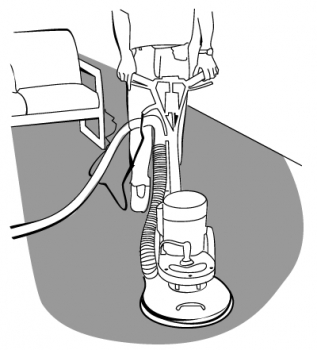
To keep your carpet looking new and fresh, it has to be kept clean. Without regular cleaning, your carpet will quickly become clumped, matted and look older and more worn than it needs to. Dirt can not only soil the appearance of the carpet, it can cause abrasion at the base of the fibres, weakening them and causing threadbare patches. This will be especially noticeable in high traffic areas like hallways, foyers and loungerooms.
Basic carpet cleaning and maintenance
Keeping your carpet clean isn’t too complicated. Depending on the climate where you live (and your heating setup) you may even want to consider going barefoot or only wearing socks on carpeted floors. Dirt can accumulate much faster from shoes scuffing over the surface. A weekly vacuum for the whole carpet and perhaps twice weekly in high traffic areas will be sufficient to keep most of the dirt from settling in. Use a HEPA filtered vacuum to ensure that the dust you’re gathering isn’t just blowing back out into the air through the exhaust.
Dry cleaning carpets
Eventually, just about every carpet will build up with particles and grime that can’t be vacuumed out. This can cause matting and clumping of fibres, and leave your carpet looking flat, lifeless and not particularly pleasant to lie down on. The carpet should be steam or dry cleaned when it gets to this stage - or at least once per year. The warranty for your carpet may even require that you periodically steam or dry clean it as well. Always check with the manufacturer to find out whether steam or dry cleaning is preferred, as some carpet fibres can react badly with the high moisture content of steam cleaning.
How to deal with stains and spills on carpets
Stains and spills should be cleaned up as soon as they occur, wherever possible, to prevent them from creating a stain. Always start with the least invasive method of cleaning - don’t reach for the stain remover right away, as some of them can be quite harsh and cause lightening of the colour or weakening of the fibres.
Blot (don’t scrub) the spill thoroughly with paper towels to remove what you can first. If this doesn’t totally remove the stain, rinse the area with a little cold water to dilute it, blot this up and repeat couple of times until the stain is washed out. If it still remains, a little carpet shampoo can be applied. There are many different types of stains, and methods for removing them can vary between carpet fibres, so if the methods above don't work, some extra research may be necessary on the best method of removing the particular stain you’re dealing with.
How to patch a hole in carpet
To patch a hole in a carpet, you will first need an offcut to work with. If you don’t have one from when the carpet was laid, you may be able to cut a small piece off from underneath a cupboard or other large permanent fixture.
Find a can or other container large enough to cover the hole and still have some space around it. Press the can firmly down onto the back of the offcut and carefully cut around it using a utility knife. Mark with tape on top of the carpet to show which way the nap is going.
Next, using the same container, cut a hole in your carpet around the damaged portion. Cut two lengths of carpet tape a finger's length longer than the hole on either side. Stick these bits of carpet tape to the underside of your carpet, leaving the sticky side of the tape facing up, out of the hole. Then, being careful to line up the direction of the nap, insert the cut off piece. Trim any long fibres away, then leave a heavy pile of books or other flat load to sit on that patch for a day or two to ensure it is secured firmly.





